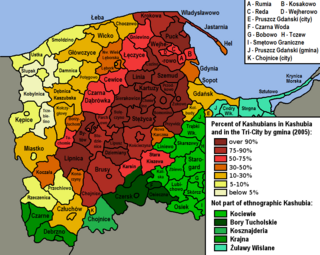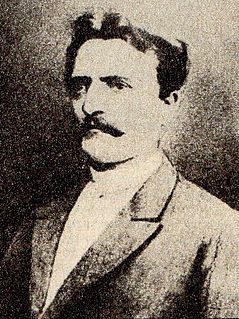Related Research Articles

The Kashubians, also known as Cassubians or Kashubs, are a Lechitic ethnic group native to the historical region of Pomerania, including its eastern part called Pomerelia, in north-central Poland. Their settlement area is referred to as Kashubia. They speak the Kashubian language, which is classified as a separate language closely related to Polish.

Winona is a city in and the county seat of Winona County, in the state of Minnesota. Located in bluff country on the Mississippi River, its most noticeable physical landmark is Sugar Loaf. The city is named after legendary figure Winona, who some sources claimed was the first-born daughter of Chief Wapasha of the Dakota people. The population was 25,948 at the 2020 census.

Polish Americans are Americans who either have total or partial Polish ancestry, or are citizens of the Republic of Poland. There are an estimated 9.15 million self-identified Polish Americans, representing about 2.83% of the U.S. population. Polish Americans are the second-largest Central European ethnic group after German Americans, and the eighth largest ethnic group overall in the United States.

Stanisław Kostka S.J. was a Polish novice of the Society of Jesus. He is venerated in the Catholic Church as Saint Stanislaus Kostka.

St. Josaphat is a historic church of the Roman Catholic Archdiocese of Chicago located at 2311 North Southport Avenue in Chicago, Illinois.

Paul Peter Rhode was a Kashubian German-born prelate of the Roman Catholic Church, and the first to be elevated to an American bishopric. He served as bishop of the Diocese of Green Bay, Wisconsin from 1915 until his death in 1945.
Pine Creek is an unincorporated community located in the town of Dodge, Trempealeau County, Wisconsin, United States. Pine Creek is located on Pine Creek and County Highway G 9.6 miles (15.4 km) west-northwest of Galesville.

The Basilica of Saint Stanislaus Kostka is a historic church of the Roman Catholic Diocese of Winona in Winona, Minnesota, United States, and a prominent fixture on the city's skyline. Within the diocese it is better known as Saint Stan's. It was listed on the National Register of Historic Places in 1984 as Church of St. Stanislaus–Catholic and was designated as a Minor Basilica of the Roman Catholic Church on November 10, 2011 by Pope Benedict XVI.

Sacred Heart-Saint Wenceslaus Church in Pine Creek, Wisconsin, referred to in Polish as Kościół Najświętszego Serca Pana Jezusa i Świętego Wacława, is a historic church of the Roman Catholic Diocese of La Crosse. It is known simply as Sacred Heart.

Jan Romuald Byzewski, better known in America as Father Romuald Byzewski, was born in the Kaszubian village of Karwia, in the Prussian jurisdiction of Danzig (Gdansk), on Oct. 10, 1842.

Jakub Wałenty Jan Pacholski, better known in America as Monsignor James W.J. Pacholski, was born on May 24, 1862 in the village of Pączewo, located in the Polish region of Kociewie.
Józef Franciszek Darzyn Ciemiński was a Polish-born Roman Catholic priest. He emigrated with his parents to the United States in 1881 and was ordained as a Priest in Saint Paul, Minnesota in 1895. He was involved with numerous Polish Catholic parishes during his lifetime including the now closed troubled Parish of Saints Peter and Paul in Duluth, Minnesota and the parish of Holy Cross in Minneapolis.

The Polish Cultural Institute and Museum is located at 102 Liberty Street in Winona, Minnesota, United States. Known locally as the Polish Museum, it is housed in a lumber yard office built by the Laird-Norton Lumber Company in 1890.
The Kashubian diaspora resulted from the emigration of Kashubians mainly in two waves occurring in the second half of the 19th century. The majority of Kashubian emigrants settled in the United States; others emigrated to Canada and Brazil. An online genealogical project, "The Great Kashubian Migration," is devoted to tracking their settlement patterns. Their reasons for emigration varied. Until the Franco-Prussian War, Kashubians emigrated primarily for economic reasons. After the Franco-Prussian War and especially due to the Kulturkampf, Kashubian emigration accelerated as socio-political factors came into play. In his 1899 book, Statystyka ludnosci kaszubskiej, the Kashubophile linguist and sociologist Stefan Ramult estimated that 130,700 Kashubians were living in the Americas.

Hieronim Derdowski, Kashubian-Polish intellectual and activist, was born to Kashubian parents in the Pomeranian village of Wiele. By the time Derdowski emigrated to the United States in 1885, he had already studied for the Roman Catholic priesthood, been repeatedly incarcerated by the German authorities, and edited a newspaper in the city of Torun. At the time, however, Derdowski was better known as a poet. Within two years of reaching the United States he became editor of the Winona, Minnesota Polish-language newspaper Wiarus. In this role he gained a reputation as a strong voice for the Polish-American community, also known as Polonia.
Paul Joseph Breza, Roman Catholic priest and Kashubian American activist, was born in Winona, Minnesota on June 23, 1937, the son of Joseph Peter and Alice Seraphine (Pehler) Breza, both of whom were descendants of Kashubian immigrants from Bytów, Poland. He was educated at Saint Stanislaus Kostka School, Cotter High School and Saint Mary's University of Minnesota.
Antoni Klawiter, the Roman Catholic and, afterward, independent Polish Catholic priest, was born in Chojnice, in modern Poland, on November 12, 1836. The scholarly consensus is that he was the son of Polonized Germans; by virtue of his Kashubian birthplace and his later experience pastoring Kashubians in Winona, Minnesota, he will not have been unfamiliar with the Kashubian culture. In 1859, he was ordained a Roman Catholic priest in Włocławek, and became four years afterward one of many Polish priests who were involved with the Polish Insurrection of 1863. In late 1873 or early 1874, Father Klawiter emigrated to the United States.
Kashubian Americans are Americans of Kashubian descent.
The History of Winona, Minnesota as a settlement begins with the foundation in 1851 in what was then Minnesota Territory on the West side of the Mississippi River. The site was of the village of Keoxa of Dakota people. The name "Winona" (Wee-no-nah) was noted to be the name of a first-born daughter in the local Dakota language.

Stefan Ramułt was a Polish scholar who specialized in the language and culture of the Kashubians.
References
- ↑ "Katolik".
- ↑ "Kashubian Capital of America – Bambenek.org". bambenek.org. Retrieved 2017-07-21.
- ↑ Fifty Years in the Northwest: With an Introduction and Appendix Containing Reminiscences, Incidents and Notes, p. 729.
- ↑ Leo M. Ochrymowycz, "Polish People of Southeastern Minnesota: Ethnic Heritage," in Gerald J. Langowski (ed.) The Polish Heritage (Winona: 1981), p. 160.
- ↑ Ochrymowycz, "Polish People..." p. 162.
- ↑ Karen Majewski, Traitors and True Poles: Narrating a Polish-American Identity, 1880-1939, pp. 36-40.
- ↑ Rev. Waclaw Kruszka, A History of the Poles in America to 1908, volume 3, page 272.
- ↑ Ochrymowycz, "Polish People..." pp. 161-162.
- ↑ Saint Paul Daily Globe, August 25, 1888
- ↑ Winona Daily Republican, January 19, 1889.
- ↑ "A Picture of the Polish Press in America (Editorial)". flps.newberry.org. Archived from the original on 2016-03-04.
- ↑ "Resolution Adopted at Mass Meeting of Parishioners of St. Stanislaus Kostka Parish". flps.newberry.org. Archived from the original on 2016-03-04.
- ↑ http://flps.newberry.org/article/5423968_10_0876 [ dead link ]
- ↑ "Archived copy". Archived from the original on 2014-01-08. Retrieved 2012-08-27.
{{cite web}}: CS1 maint: archived copy as title (link) - ↑ Winona Daily Republican, December 18, 1919.